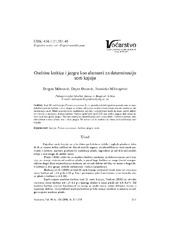Приказ основних података о документу
Stone and kernel characteristics as elements in identification of apricot cultivars
Osobine koštice i jezgre kao elementi za determinaciju sorti kajsije
| dc.creator | Milatović, Dragan | |
| dc.creator | Djurović, Dejan | |
| dc.creator | Milivojević, Jasminka | |
| dc.date.accessioned | 2020-12-17T18:46:13Z | |
| dc.date.available | 2020-12-17T18:46:13Z | |
| dc.date.issued | 2006 | |
| dc.identifier.issn | 1820-5054 | |
| dc.identifier.uri | http://aspace.agrif.bg.ac.rs/handle/123456789/1245 | |
| dc.description.abstract | The research into the morphological characteristics of the fruit stone was done in 30 apricot cultivars over a period of four years, with an aim to determine the most important characteristics for cultivar identification. The average mass of the stone ranged from 1.8 g in cv Fruhe Kittse, to 4.2 in cv Silistrenska Kompotna. The participation of stone in the total fruit mass ranged from 5% in cvs Ligeti Orijas, Szegedi Mammut and Selena, to 11.3% in cv Stella. Among the examined stone properties, the highest variability was recorded in the mass, then the thickness and the width. The lowest variability was recorded in the stone length. The variation coefficients in the stone properties were lower than the corresponding coefficients in the fruit characteristics. Based on the mass, the shape and the participation of the stone mass in the mass of the fruit, the apricot cultivars were classified into groups. The majority of the examined cultivars (23) had a sweet kernel, while only seven of them had a bitter kernel. The most important characteristics of the fruit stone used in identification of apricot cultivars are: the shape, the size, the participation of the stone mass in the total mass of the fruit, and the taste of the kernel. Although stone properties alone are not sufficient to enable successful classification of apricot cultivars, they can be used as an indicator to supplement other properties such as the phonological features, as well as the features of the fruit, tree or leaf. | en |
| dc.description.abstract | Kod 30 sorti kajsije (Prunus armeniaca L.) u periodu od četiri godine proučavane su morfološke osobine koštice i ukus jezgre sa ciljem izdvajanja osobina koje imaju najveći značaj za determinaciju sorti. Među proučavanim osobinama najveću varijabilnost imala je masa, zatim debljina i širina, a najmanju dužina koštice. Većina ispitivanih sorti (23) ima slatku jezgru, dok samo sedam sorti ima gorku jezgru. Najveći značaj za identifikaciju sorti imaju oblik i veličina koštice, učešće koštice u masi ploda, kao i ukus jezgre. Na osnovu ovih osobina izvršena je klasifikacija sorti kajsije. | sr |
| dc.publisher | Naučno voćarsko društvo Srbije, Čačak | |
| dc.rights | openAccess | |
| dc.source | Voćarstvo | |
| dc.subject | apricot | en |
| dc.subject | Prunus armeniaca | en |
| dc.subject | stone | en |
| dc.subject | kernel | en |
| dc.subject | cultivar | en |
| dc.subject | kajsija | sr |
| dc.subject | Prunus armeniaca | sr |
| dc.subject | koštica | sr |
| dc.subject | jezgra | sr |
| dc.subject | sorta | sr |
| dc.title | Stone and kernel characteristics as elements in identification of apricot cultivars | en |
| dc.title | Osobine koštice i jezgre kao elementi za determinaciju sorti kajsije | sr |
| dc.type | article | |
| dc.rights.license | ARR | |
| dc.citation.epage | 319 | |
| dc.citation.issue | 156 | |
| dc.citation.other | 40(156): 311-319 | |
| dc.citation.spage | 311 | |
| dc.citation.volume | 40 | |
| dc.identifier.fulltext | http://aspace.agrif.bg.ac.rs/bitstream/id/215/1242.pdf | |
| dc.identifier.rcub | https://hdl.handle.net/21.15107/rcub_agrospace_1245 | |
| dc.type.version | publishedVersion |


